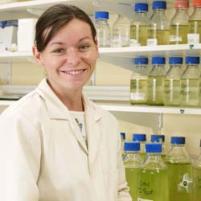Crocs not only danger in Fitzroy River
Published on 17 December, 2004
A PhD student is looking into the potentially hazardous blue green algae species sometimes present in the Fitzroy River.
Susan White (pictured), a researcher for CQU's Centre for Environmental Management (CEM), is conducting a unique study into the potentially deadly toxins produced by the blue green algal species, Cylindrospermopsis raciborskii.
 "The study is very important locally because I study a strain originally found in our Fitzroy River," Ms White explained.
"The study is very important locally because I study a strain originally found in our Fitzroy River," Ms White explained.
In particular, Ms White is interested in what environmental effects algal toxins have on organisms that live in waters contaminated by toxic blooms of algae.
Laboratory tests are underway to examine how toxins contaminate the organisms, and what this could mean for the health of our waterways.
Another part of Ms White's study looks at the potential health risks associated with toxins accumulating in organisms likely to be eaten by humans (e.g. fish).
"The ultimate aim of the project is to increase our understanding of toxic algae and how best to manage them in our local waterways.".
"This particular species of blue green algae is considered an 'adaptive' and 'expanding' species. What this means to the lay-person is that this species is capable of invading new habitats and is therefore turning up all over the world, causing potentially toxic blooms in places it previously was not known from.".
The species is a producer of a highly potent toxin, named cylindrospermopsin. This toxin has been known to physically harm, and even cause death in a range of plants, animals, stock (e.g. cattle) and humans.
"This toxin was implicated in the hospitalisation of over 100 people (mostly children), on Palm Island in Queensland's tropical north, after a toxic bloom contaminated the water reservoir there.
"Therefore, understanding this alga, and its toxin, is vitally important to ensuring our waterways remain healthy.".
--ENDS--.
For further details/interview contact Susan White on (07) 4930 9647.

